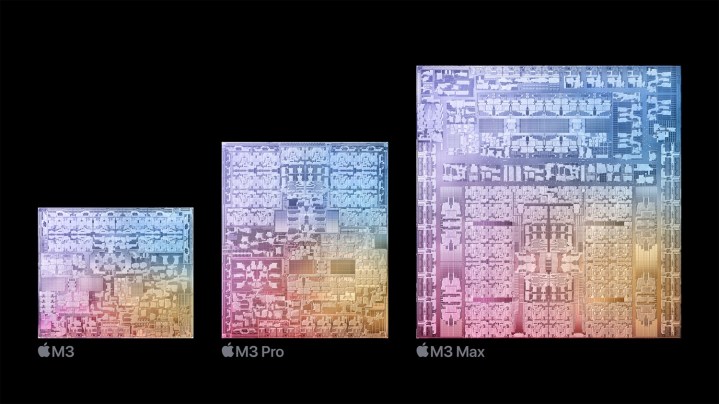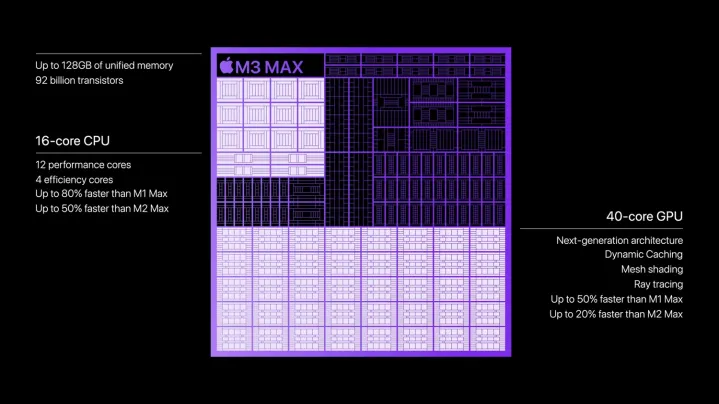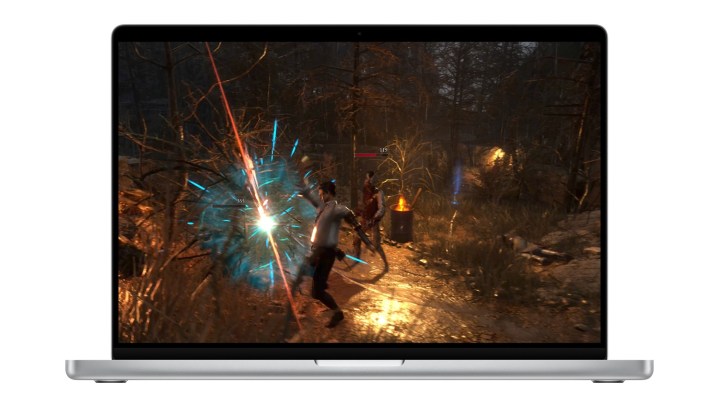Apple’s next generation of MacBook Pros is finally here, and they arrive touting the highly anticipated M3 chip. Like the previous generation, you have a choice between a 14-inch and 16-inch model, but there are a lot of differences when you start looking at the three versions of the chip that are available: the M3, M3 Pro, and M3 Max.
We’re here to run you through all of the configuration options for the MacBook Pro M3, as well as if you should choose the M3, M3 Pro, or M3 Max. Apple currently has the
, and they’ll be released on November 7.
Pricing

There’s a wide range of pricing options for the M3 MacBook Pros depending on how you configure them. For the 14-inch model, you can get your foot in the door for $1,600,which gets you the base M3, 8GB of Unified Memory, and 512GB of storage. Apple offers two other stock configurations: one that costs $1,800 and upgrades the cheapest model to 1TB of storage, and another that comes with an 11-core CPU, 14-core GPU M3 Pro with 18GB of Unified Memory and 512GB of storage for $2,000.
You can scale these much higher. The 12-core CPU, 18-core GPU M3 Pro will run you an extra $200 compared to the base model, while the M3 Max with 16 CPU cores and 40 GPU cores will run you an extra $900. A fully tricked-out 14-inch MacBook Pro with the highest M3 Max, 128GB of Unified Memory, and 8TB of storage will run you $6,900.
The 16-inch model is much more expensive. You’ll spend $2,500 for the cheapest model, which comes with the 12-core CPU and 18-core GPU configuration of the M3 Pro, along with 18GB of Unified Memory and and 512GB of storage. To get 36GB of memory, you’ll need to spend an extra $400, and for 4TB of storage, where the M3 Pro maxes out, you’ll spend an extra $1,200.
Apple offers two configurations of the M3 Max with the 16-inch MacBook Pro, one with a 14-core CPU and 30-core GPU, and another with a 16-core CPU and 40-core GPU. The former will run you an extra $400 compared to the $2,500 base model, while the latter clocks in at an extra $700. Both the M3 Max configurations start with 48GB of memory, and they can scale up to 128GB of memory for an extra $1,000. In addition, you can pack in up to 8TB of storage for an extra $2,400.
Although the 16-inch MacBook Pro starts at a much higher price, it’s not too much more than the 14-inch MacBook when it’s maxed out. You’ll spend $7,200 for the top M3 Max, 128GB of Unified Memory, and 8TB of storage.
Color options

Normally, color options aren’t a big deal on the MacBook Pro. Pick the one you like, and you’re on your way. Apple is doing something strange with its M3 MacBook Pros, though. It introduced the new Space Black color to the MacBook Pro, but you can’t get it on every model.
You can get Space Black on both the 14-inch and 16-inch MacBook Pros, but only with an M3 Pro or M3 Max chip. If you go with the M3 chip, you can choose Space Gray instead. All models come with silver as an option as well.
It’s bizarre for Apple to restrict a color option to a particular chip, but it’s an important note if you were hoping to get your hands on one of the best-looking MacBooks Apple has ever made.
M3 vs. M3 Pro vs. M3 Max

The only product Apple currently has that supports the M3, M3 Pro, and M3 Max is the 14-inch MacBook Pro. There are only three chip options, but Apple has several configurations of each that are slightly different.
Starting with the M3, Apple is only offering it with an 8-core CPU and a 10-core GPU, though it’s worth noting that the 24-inch iMac with this chip can scale down to an 8-core GPU. Things are more complicated as you move up the stack. The M3 Pro in the 14-inch MacBook Pro is available with an 11-core CPU and 14-core GPU, or a 12-core CPU and 18-core GPU. Similarly, the M2 Max is available with a 14-core CPU and 30-core GPU, or a 16-core CPU and 40-core GPU.
On the 16-inch MacBook Pro, the options are a bit more streamlined. You don’t have the base M3 as an option, and if you want the M3 Pro, Apple is only offering it with a 12-core CPU and 18-core GPU. The M3 Max configurations remain unchanged with a 14-core CPU and 30-core GPU option, as well as a 16-core CPU and 40-core GPU option.
The choice between the M3 chips influences some other configuration options. With the base M3 in the 14-inch MacBook Pro, you have access to up to 24GB of Unified Memory, along with up to 2TB of storage and a 96-watt power adapter. The M3 Pro can scale up to 36GB with up to 4TB of storage, while the M3 Max offers up to 128GB with up to 8TB of storage. Those options don’t change on the 16-inch MacBook Pro, though it comes with a 140-watt power adapter by default.
M3 vs. M3 Pro vs. M3 Max performance

We don’t know exactly how performance scales across the M3, M3 Pro, and M3 Max, but we have some comparisons to the previous two M-series chips from Apple to get an estimate. Based on what Apple has shown, the M3 and M3 Pro offer decent generational improvements overall, mainly on the back of an enhanced GPU, while the M3 Max looks like it shoots ahead.
Apple says the M3 Max offers 50% faster CPU performance and 20% faster GPU performance compared to the M2 Max. In real applications, that plays out around twice the performance of the M1 Max in applications like MathWorks and Maxon Redshift. For context, Apple is only claiming an improvement of 10% in the GPU for for the M3 Pro compared to the previous generation and no CPU advantage at all.
The base M3 doesn’t scale as high as the M3 Max, but it looks more impressive than the M3 Pro. Apple says it offers up to 20% faster CPU and GPU performance compared to the M2, and up to 35% faster CPU and 65% faster GPU performance compared to the M1. In practice, that plays out with the M3 showing 40% faster image filter and effects performance compared to the M2, according to Apple.

Although it’s tough to extrapolate how each of the chips compare to each other, the M3 Pro is clearly the ugly duckling of the lineup. If you just want solid performance out of your MacBook Pro, you should stick with the base M3 in the 14-inch model. Pro users are better off spending up for the M3 Max, however. Even the model with a 30-core GPU looks leagues faster than the M3 Pro.
There are some important caveats here, especially while we wait for third-party benchmarks. It’s not clear how the different configurations of the M3 Pro and M3 Max will influence performance, so it’s possible you could either save some money or get higher performance by spending a little more depending on how reviews shake out. In addition, we don’t know how the M3 Pro and M3 Max will scale across the 14-inch and 16-inch MacBook Pro. Given the larger size of the 16-inch model, it wouldn’t be surprising to see the M3 Pro and M3 Max offer higher performance compared to the 14-inch model, but we’ll just have to wait until the products are available to find out for sure.
What should you pick?

There are a ton of configuration options for the M3 MacBook Pros, but there are three main configurations we recommend. Here’s what you should get for the 14-inch MacBook Pro:
- M3 chip
- 16GB Unified Memory
- 1TB of storage
- $2,000
There’s a lot of room to go higher, so you can add more storage or memory as needed. The main thing is to skip the M3 Pro chip with the 11-core CPU and 14-core GPU. The M3 Pro already looks like a disappointing chip, and you don’t want a cutdown version of it. If you still want the M3 Pro, here’s what you should get in the 14-inch MacBook Pro:
- M3 Pro with 12-core CPU and 18-core GPU
- 36GB Unified Memory
- 1TB of storage
- $2,600
For the M3 Max, we recommend going with the 16-inch MacBook Pro for now. It’s possible that could change once we see how the chip performs in the smaller 14-inch model, but it’s reasonable to assume the 16-inch model will reach higher peak performance. With that chip, here’s what we recommend:
- M3 Max with 16-core CPU and 40-core GPU
- 48GB Unified Memory
- 1TB of storage
- $4,000
These configurations hit the sweet spot in Apple’s lineup of M3 MacBook Pros. As is usually the case, Apple charges a lot for extra storage, so we recommend using an external hard drive if you need beyond 1TB. If you need fast storage on the laptop itself, expect to spend hundreds or even thousands more depending on how much you need.
Editors’ Recommendations
